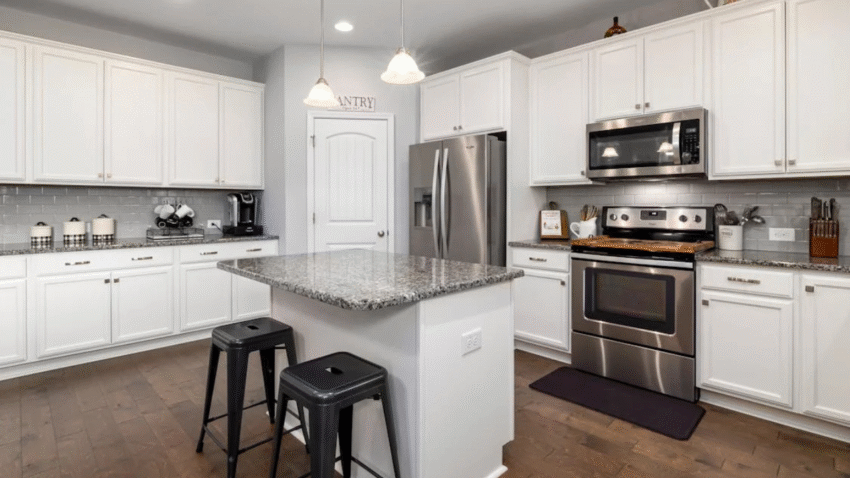Introduction
Ever opened a kitchen cabinet and found leaky bottles or harsh chemical smells? Storing cleaning supplies in the kitchen is convenient—but it must be done correctly. Knowing how to store cleaning products safely in the kitchen is vital for protecting your health, preventing accidents, and keeping your space organized. This complete guide will show you step-by-step how to store sprays, soaps, and scrubs the right way—without endangering your food, family, or furry friends.
Why Safe Storage of Cleaning Products Matters in the Kitchen
Your kitchen is a high-traffic, food-prep area—meaning safety and cleanliness must go hand-in-hand. Many cleaning products contain strong chemicals that can harm children, pets, and food if not stored properly.
Here’s why this matters:
- Health Protection: Prevents toxic exposure from accidental spills or mix-ups.
- Food Safety: Keeps cleaners away from food and utensils to avoid contamination.
- Fire Safety: Some chemicals are flammable and should be kept away from heat sources.
- Organization: A tidy storage system makes daily cleaning easier and safer.
From under-sink cabinets to wall-mounted caddies, storing cleaners properly is a smart move in every kitchen.
Step-by-Step Guide to Storing Cleaning Products Safely in the Kitchen
1. Choose the Right Storage Location
Pick a spot that’s safe, accessible, and separate from food:
- Under the sink is common, but only if you childproof it.
- Use a high cabinet if there are kids or pets in the home.
- Avoid storing cleaners next to the stove or oven, where heat can affect chemicals.
- Never store them in the same space as food, plates, or cooking tools.
Kitchen Tip: Install a lock or latch on under-sink cabinets to prevent access by curious little hands or paws.
2. Use Storage Bins or Caddies
Keep bottles upright and contained using:
- Plastic bins or totes with high sides
- Pull-out drawers or baskets for easy access
- Wall-mounted organizers for small bottles or sprays
Group similar items together—like all-purpose cleaners, dish soaps, sponges, or specialty products.
Pro Tip: Line the base of your cabinet or bin with a rubber mat to catch leaks or spills.
3. Separate Hazardous from Non-Hazardous Items
Some cleaning products are more dangerous than others:
- Store bleach, ammonia, drain cleaners, and oven cleaners on a different shelf or in a separate bin.
- Keep mild cleaners (like dish soap or vinegar-based sprays) in easier-to-access zones.
Safety Reminder: Never store bleach and ammonia together—they can create toxic fumes if mixed accidentally.
4. Label Everything Clearly
If you’ve transferred products into spray bottles or reusable containers:
- Label each one clearly with its contents and usage.
- Add a warning label if it’s a strong chemical or irritant.
- Use waterproof labels so writing doesn’t wear off with moisture.
Kitchen Hack: Color-code your spray bottles (e.g., red for disinfectant, blue for glass cleaner) for quick identification.
5. Keep Products in Original Containers When Possible
Most cleaning products come in bottles designed to handle the chemical inside:
- Original containers include safety instructions, dilution guides, and warnings.
- Transferring them can weaken packaging or remove essential safety info.
Exception: If you use DIY natural cleaners (like vinegar + baking soda mixes), just be sure your container is clearly labeled and stored safely.
6. Ventilate the Storage Area
Good airflow helps prevent chemical buildup and reduces odors:
- Keep the area under your sink dry and mold-free.
- Install vent slots or leave the cabinet slightly ajar after cleaning to air it out.
- Avoid storing products near warm appliances or in humid areas.
Moisture Alert: Humidity and heat can degrade some cleaning formulas over time and encourage mold.
Common Mistakes to Avoid
Mistake 1: Storing Cleaners With Food
Solution: Always store cleaning products away from your pantry, fridge, and dishes. Even a sealed cleaner can leak or emit fumes.
Mistake 2: Leaving Bottles Unsecured
Solution: Use bins and caddies to prevent bottles from tipping or leaking. Lock cabinets if kids or pets are around.
Mistake 3: Mixing Unknown Chemicals
Solution: Never mix two cleaning products unless the label says it’s safe. Many combinations create harmful reactions.
Mistake 4: Using Unlabeled Spray Bottles
Solution: Always label homemade or repurposed containers with both the ingredients and safety warnings.
Mistake 5: Ignoring Expiration Dates
Solution: Some cleaning products lose effectiveness over time or become unstable. Check dates yearly and dispose of old ones safely.
Extra Tips & Kitchen Hacks
Tip 1: Keep a Cleaning Inventory
Create a checklist of what you store under the sink. It helps avoid overbuying and reminds you when to restock essentials like gloves, dish soap, or disinfectant.
Tip 2: Use a Lazy Susan
Install a small turntable in your cabinet for easy access to frequently used items without knocking things over.
Tip 3: Store Gloves and Cloths Separately
Use a hook or clip on the inside of the cabinet door to hang cleaning gloves or cloths. Keep them dry and away from chemicals.
Related Task: Check out our article on how to safely store cleaning chemicals for deeper tips on overall household cleaning safety.
Conclusion
Storing cleaning products safely in your kitchen is about more than just tidiness—it’s about protecting your home and everyone in it. With the right containers, separation, labeling, and ventilation, you can prevent accidents, stay organized, and make your cleaning routine smoother and safer.
Bookmark this guide to keep your kitchen clean, efficient, and chemical-safe all year round.
